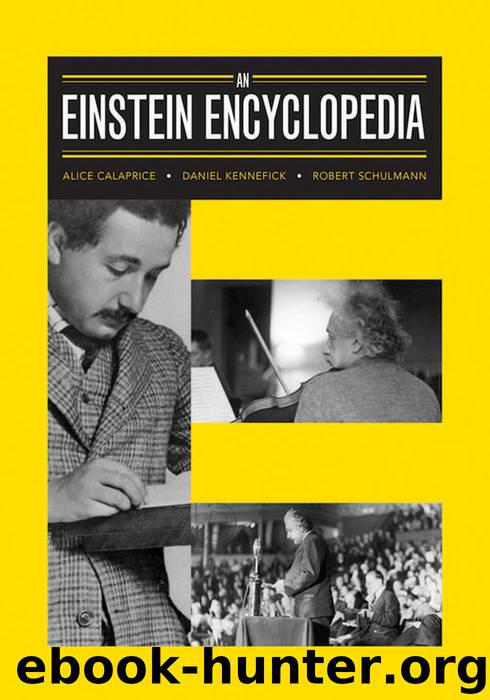An Einstein Encyclopedia by Calaprice Alice; Kennefick Daniel; Schulmann Robert

Author:Calaprice, Alice; Kennefick, Daniel; Schulmann, Robert
Language: eng
Format: epub
Publisher: Princeton University Press
Published: 2015-09-02T16:00:00+00:00
Quantum Mechanics
Quantum mechanics emerged in the mid-1920s, most notably through the work of Werner Heisenberg and Erwin Schrödinger, who discovered the governing equations of the new theory. While it is widely known that Einstein objected to important elements of the new theory, he contributed significantly to its development. In addition to being one of the chief architects of the original quantum theory (which lacked an explanation of the mechanics of quantum particles and instead focused on the creation and absorption of such particles rather than their general motion), he was also the originator of the concept of wave-particle duality (see below). The duality concept was fundamental to the development of quantum mechanics and instrumental in the statistics of quantum theory (see “Bose-Einstein Statistics,” above).
It came as a shock to many physicists, especially Einstein’s close friends such as Max Born and Paul Ehrenfest, that Einstein rejected quantum mechanics. It seemed in many ways the culmination of many of the ideas Einstein had introduced or championed in physics. Einstein was the master of the statistical approach to physics, especially emphasizing how the nature of fluctuations (departures from the average in a statistical ensemble of particles) could yield insight into the microscopic world. Ironically, it was the statistical aspect of the new theory that most bothered Einstein. He had always believed strongly that certain aspects of nature arose only in the ensemble (see “Arrow of Time,” above). Fundamental theories and their equations did not show traces of these statistically based phenomena, such as the arrow of time and the unpredictability of individual fluctuations. The fact that the quantum mechanics included only a probabilistic prediction of the behavior of individual particles meant that, for Einstein, it could not be a truly fundamental theory. He made a number of attempts to show that the theory was incomplete, in that there was a more fundamental theory lying behind it, and he always believed that such a theory would permit separability in physicists’ treatment of fundamental particles. Given complete information about a particle, the theory should permit one to analyze its future behavior, independently of other particles (unless it actually collided or interacted with those other particles in the future).
Quantum mechanics, though, insisted that the behavior of many quantum particles was entangled, so that they had to be treated as a statistical whole. Einstein’s most cogent criticism of quantum mechanics (in the EPR paradox) attempted to show that this nonseparability of quantum systems was untenable.
Ultimately, although Einstein never became reconciled to quantum mechanics, his efforts to find a classical theory that could supersede it were unsuccessful. (See also Unified Field Theory, below.)
Download
This site does not store any files on its server. We only index and link to content provided by other sites. Please contact the content providers to delete copyright contents if any and email us, we'll remove relevant links or contents immediately.
The Complete Stick Figure Physics Tutorials by Allen Sarah(7162)
Secrets of Antigravity Propulsion: Tesla, UFOs, and Classified Aerospace Technology by Ph.D. Paul A. Laviolette(5085)
Thing Explainer by Randall Munroe(3802)
The River of Consciousness by Oliver Sacks(3432)
The Order of Time by Carlo Rovelli(3081)
How To by Randall Munroe(2929)
I Live in the Future & Here's How It Works by Nick Bilton(2855)
A Brief History of Time by Stephen Hawking(2834)
What If?: Serious Scientific Answers to Absurd Hypothetical Questions by Randall Munroe(2552)
The Great Unknown by Marcus du Sautoy(2551)
Midnight in Chernobyl by Adam Higginbotham(2397)
Blockchain: Ultimate Step By Step Guide To Understanding Blockchain Technology, Bitcoin Creation, and the future of Money (Novice to Expert) by Keizer Söze(2385)
Networks: An Introduction by Newman Mark(2278)
Easy Electronics by Charles Platt(2223)
The Meaning of it All by Richard Feynman(2222)
The Tao of Physics by Fritjof Capra(2177)
Midnight in Chernobyl: The Untold Story of the World's Greatest Nuclear Disaster by Adam Higginbotham(2088)
When by Daniel H Pink(2028)
Introducing Relativity by Bruce Bassett(2025)
